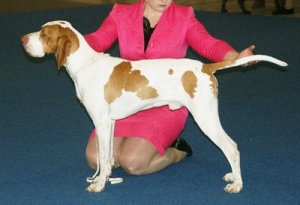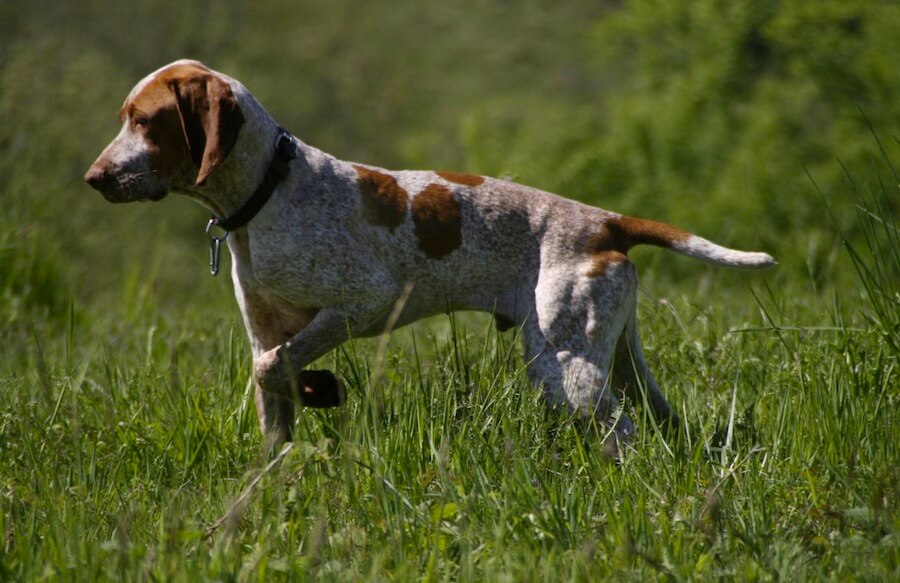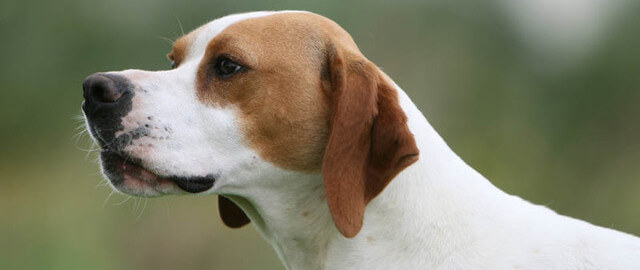Meet the Ariege Pointer: A Hunter Dog

Today, we want to talk to you about a dog breed that isn’t very famous even in its own country of origin. We’re referring to the Ariege Pointer. This is a dog that we’ve particularly loved researching in order to share more with you about it. Would you like to learn more? Keep reading!
Everything you need to know about the Ariege Pointer
History and origin
The Ariege Pointer breed comes from France and, even in this country today, it’s little known. Since its appearance up to present times, people have always used this dog for hunting and not much as a pet. The breed was created in the nineteenth century through crosses between the French Braco and other Bracos from southern areas that had white or orange hair.
This breed didn’t gain much popularity at first, perhaps because of the kind of work it performed. People also didn’t consider them suitable to have as pets. In addition, the breed almost became extinct in the ’80s, but some breeders decided to preserve it and, in the ’90s, it was once again on the rise.
The Ariege Pointer still exists today, but you probably wouldn’t know about it unless you look at small game hunting. However, the breed is unknown sometimes even among many hunters whether from France or other countries.

Appearance
The Ariege Pointer is a robust, medium-sized dog with a powerful appearance. They’re light but vigorous and also very resistant. Combined with this, their proportions bring harmony and elegance to their figure. Although their limbs are thin, they’re straight and muscular, strong and robust, and with long thighs.
Males can be between 23 and 26 inches high, while females are between 22 and 25 centimeters. Their weight ranges from 55 to 66 kilos and their life expectancy is from 12 to 14 years.
Their tails are thick at the base and get thinner outwards. However, their owners usually cut it off to avoid discomfort while at a hunt. They have long heads with a straight muzzle, which almost creates a 90-degree angle. In addition, they possess long, thin, crooked ears that reach the nose level.
This Pointer’s coat is short, tough and plentiful, and has a softer undercoat. The usual coat colors are mainly white and fawn with orange or brown spots.
Temperament
Despite having always been a hunting and tracking dog, the Ariege Pointer is very versatile and adaptable. This means the dog could easily adapt to other tasks other than hunting and game.
Although it’s not one of the most sought-after dogs to have as a companion animal, they’re loving, intelligent and very docile. The Ariege Pointer will be suitable for living in rural areas, although they could also adapt to living in small apartments. Moreover, they love having company and are very familiar, which makes them ideal for living with children.
In summary, it’s a rather balanced dog in this sense, gets along well with other dogs and pets and is very easy to train. However, it should be kept in mind that the Ariege is a very active dog. If it gets bored or remains inactive for too long then it could become destructive and bark a lot. This is common among sporting dogs of this size.

Special care for the Ariege Pointer
Although this breed doesn’t have any common health problems in general, there are certain factors to consider. Their ears, for example. Ideally, owners must check them as often as they can, for they could hide infectious bacteria. This is especially so because they have a long drop which isn’t easy to notice.
If you use the Ariege for hunting, you must carefully check them every time after going out. This is to make sure there are no spikes or parasites in its skin and hair. And, of course, as we said before, this is a very active animal and exercise will be an essential part of its routine.
Although this special Pointer hasn’t been used much as a pet, it’s very suitable for it. Therefore, if you’re thinking of having a new friend, you might consider this breed. We hope you enjoyed learning about it!
Today, we want to talk to you about a dog breed that isn’t very famous even in its own country of origin. We’re referring to the Ariege Pointer. This is a dog that we’ve particularly loved researching in order to share more with you about it. Would you like to learn more? Keep reading!
Everything you need to know about the Ariege Pointer
History and origin
The Ariege Pointer breed comes from France and, even in this country today, it’s little known. Since its appearance up to present times, people have always used this dog for hunting and not much as a pet. The breed was created in the nineteenth century through crosses between the French Braco and other Bracos from southern areas that had white or orange hair.
This breed didn’t gain much popularity at first, perhaps because of the kind of work it performed. People also didn’t consider them suitable to have as pets. In addition, the breed almost became extinct in the ’80s, but some breeders decided to preserve it and, in the ’90s, it was once again on the rise.
The Ariege Pointer still exists today, but you probably wouldn’t know about it unless you look at small game hunting. However, the breed is unknown sometimes even among many hunters whether from France or other countries.

Appearance
The Ariege Pointer is a robust, medium-sized dog with a powerful appearance. They’re light but vigorous and also very resistant. Combined with this, their proportions bring harmony and elegance to their figure. Although their limbs are thin, they’re straight and muscular, strong and robust, and with long thighs.
Males can be between 23 and 26 inches high, while females are between 22 and 25 centimeters. Their weight ranges from 55 to 66 kilos and their life expectancy is from 12 to 14 years.
Their tails are thick at the base and get thinner outwards. However, their owners usually cut it off to avoid discomfort while at a hunt. They have long heads with a straight muzzle, which almost creates a 90-degree angle. In addition, they possess long, thin, crooked ears that reach the nose level.
This Pointer’s coat is short, tough and plentiful, and has a softer undercoat. The usual coat colors are mainly white and fawn with orange or brown spots.
Temperament
Despite having always been a hunting and tracking dog, the Ariege Pointer is very versatile and adaptable. This means the dog could easily adapt to other tasks other than hunting and game.
Although it’s not one of the most sought-after dogs to have as a companion animal, they’re loving, intelligent and very docile. The Ariege Pointer will be suitable for living in rural areas, although they could also adapt to living in small apartments. Moreover, they love having company and are very familiar, which makes them ideal for living with children.
In summary, it’s a rather balanced dog in this sense, gets along well with other dogs and pets and is very easy to train. However, it should be kept in mind that the Ariege is a very active dog. If it gets bored or remains inactive for too long then it could become destructive and bark a lot. This is common among sporting dogs of this size.

Special care for the Ariege Pointer
Although this breed doesn’t have any common health problems in general, there are certain factors to consider. Their ears, for example. Ideally, owners must check them as often as they can, for they could hide infectious bacteria. This is especially so because they have a long drop which isn’t easy to notice.
If you use the Ariege for hunting, you must carefully check them every time after going out. This is to make sure there are no spikes or parasites in its skin and hair. And, of course, as we said before, this is a very active animal and exercise will be an essential part of its routine.
Although this special Pointer hasn’t been used much as a pet, it’s very suitable for it. Therefore, if you’re thinking of having a new friend, you might consider this breed. We hope you enjoyed learning about it!
This text is provided for informational purposes only and does not replace consultation with a professional. If in doubt, consult your specialist.








